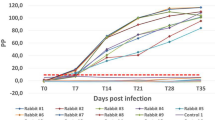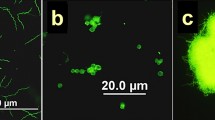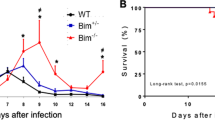Abstract
HUMAN and experimental forms of African trypanosomiasis are characterised by a profound suppression of immunological responsiveness. Suppression of both humoral and cell-mediated responses has been observed. Trypanosoma gambiense infections in man reduce antibody responses to Salmonella typhi (H antigen) and skin reactivity to purified protein derivative, Candida and dinitrochlorobenzene1. T. brucei infections in mice cause marked suppression of antibody2 and splenic plaque-forming cell3,4 responses to sheep red blood cells (SRBC), and in rabbits suppress the development of experimental allergic neuritis5. The mechanism underlying this inhibition of immunocompetent cell function has not been elucidated. We have examined the DNA synthetic responses of spleen cells from T. brucei-infected mice to concanavalin A (con A) and phytohaemagglutinin (PHA) (both T-cell mitogens), Escherichia coli lipopolysaccharide (LPS, a B-cell mitogen) and allogeneic cells, and the ability of these cells to influence the responses of normal cells. We present evidence suggesting that suppressor cells6,7 are involved in the immunological hyporesponsiveness observed in this disease.
This is a preview of subscription content, access via your institution
Access options
Subscribe to this journal
Receive 51 print issues and online access
$199.00 per year
only $3.90 per issue
Buy this article
- Purchase on Springer Link
- Instant access to full article PDF
Prices may be subject to local taxes which are calculated during checkout
Similar content being viewed by others
References
Greenwood, B. M., in Parasites in the Immunised Host: Mechanisms of Survival, Ciba Foundation Symp., 25, 138–146 (North-Holland, Amsterdam, 1974).
Goodwin, L. G., Green, D. G., Guy, M. W., and Voller, A. Br. J. exp. Path., 53, 40–43 (1972).
Longstaffe, J. A., Freeman, J., and Hudson, K. M., Trans. R. Soc. trop. Med. Hyg., 67, 264–265 (1973).
Murray, P. K., Urquhart, G. M., Murray, M., and Jennings, F. W., Trans. R. Soc. trop. Med. Hyg., 67, 267 (1973).
Allt, G., Evans, E. M. E., Evans, D. H. L., and Targett, G. A. T., Nature, 233, 197–199 (1971).
Gershon, R. K., in Contemp. Top. Immunobiol., 3 (edit. by Cooper, M. D., and Warner, N. L.), 1–40 (Plenum, New York, 1974).
Transplant. Rev., 25 (edit. by Möller, G.) (Munksgaard, Copenhagen, 1975).
Lumsden, W. H. R., and Hardy, G. J. C., Nature, 205, 1032 (1965).
Williams, M., Cell. Immun., 9, 435–444 (1973).
Gershon, R. K., Gery, I., and Waksman, B. H., J. Immun., 112, 215–221 (1974).
Bash, J. A., and Waksman, B. H., J. Immun., 114, 782–787 (1975).
Folch, H., Yoshinaga, M., and Waksman, B. H., J. Immun., 110, 835–839 (1973).
Lanham, S. M., Nature, 218. 1273–1274 (1968).
Kumar, V., Caruso, T., and Bennet, M., J. exp. Med., 143, 728–740 (1976).
Author information
Authors and Affiliations
Rights and permissions
About this article
Cite this article
JAYAWARDENA, A., WAKSMAN, B. Suppressor cells in experimental trypanosomiasis. Nature 265, 539–541 (1977). https://doi.org/10.1038/265539a0
Received:
Accepted:
Issue Date:
DOI: https://doi.org/10.1038/265539a0
This article is cited by
-
Immunosuppression in experimental cryptococcosis in rats
Mycopathologia (1991)
-
Characteristics of DTH suppressor cells in mice infected with Candida albicans
Mycopathologia (1987)
-
Suppression of humoral response during the course of Candida albicans infection in mice
Mycopathologia (1984)
Comments
By submitting a comment you agree to abide by our Terms and Community Guidelines. If you find something abusive or that does not comply with our terms or guidelines please flag it as inappropriate.



